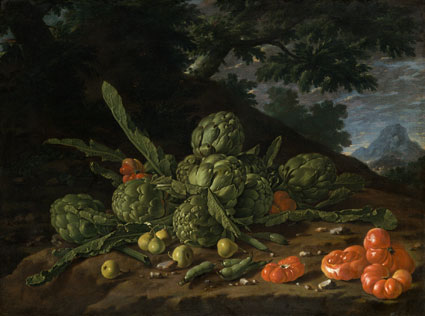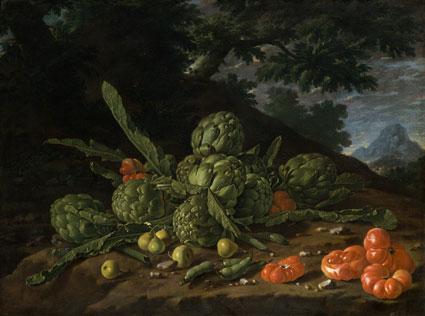Opening on Sunday (unless you’re a member, in which case it opens today) is Luis Meléndez: Master of the Spanish Still Life—collecting a number of paintings from this eighteenth-century painter whose work has only gained acclaim in the last few decades. I’m always a bit of a sucker for still-life exhibitions by a single artist. Seeing ten or twenty or thirty paintings done by the same hand, all depicting a table full of food, creates a kind of exquisite monotony. You start to hone in on the little differences—how the artist paints pears in one painting versus the same fruit in another. You also start to develop an appreciation for anyone who can devote their days to painting a version of the same image over and over again.
With Meléndez it’s especially fascinating. In large part his still lifes don’t lend themselves to metaphor the way, say, a Dutch still life might. This is really, more or less, just fruit and jugs on a table, rendered by an artist in full command of his technical abilities.
But then you get a little deeper into the show, where you find four paintings that aren’t on a table. In fact they’re not even indoors. Meléndez painted a handful of still lifes in landscapes—fruit like pomegranates or watermelons, cut open and sitting on the ground while a dark, stormy sky looms in the distance. They might be the most violent still lifes I’ve ever seen.

Luis Meléndez, "Still Life with Artichokes and Tomatoes in a Landscape," c. 1771–74, The Metropolitan Museum of Art, Mrs. Lila Shickman, image © The Metropolitan Museum of Art
Part of their drama might be found in Meléndez’s life story. In short, the artist had long aspired to be a court painter—a well-paid position that would have allowed him to paint portraits or scenes depicting great battles or religious narratives. But the position escaped him, and he ultimately died in poverty. The only commissions he did get were for still lifes. Seeing the artichokes and tomatoes strewn about the ground, they almost feel like corpses lying in the wake of some great battle, as if the artist Meléndez wanted to be is trying to find its way onto the canvas.



